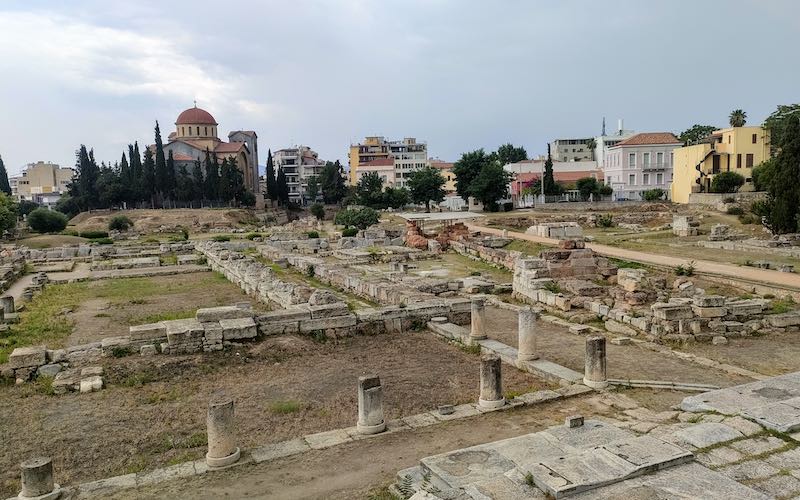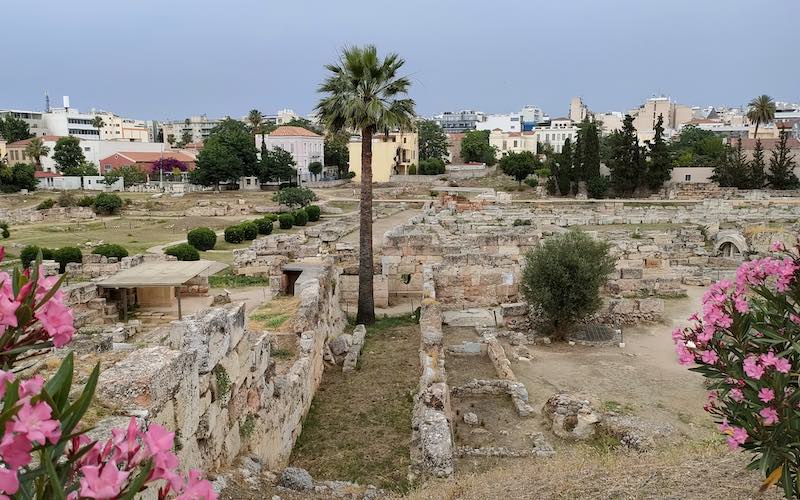Around 15 minutes walk from Monastiraki square in Athens, you can find an ancient ceremony with tombs that date back to the Bronze age. Karemeikos is one of the Northern districts in Athens that was once known as the ‘potters district’ because the ancient potters (keramais) who made the Attic vases came from. This is how Kerameikos got its name! If you are in Athens exploring the ancient archeological sites, then don’t miss Kerameikos archaeological site – it also houses the remains of bath-houses, an ancient sanctuary and the Odeon of Agrippa.
Templeseeker is a participant in the Amazon Services LLC Associates Program, an affiliate advertising program designed to provide a means for us to earn fees by linking to Amazon.com and affiliated sites. Other affiliate links may be used in this article on Kerameikos, but they do not impact on the price that you pay and they do help me to get this information to you for free. Read my privacy policy for more information regarding affiliates.
Is Kerameikos worth visiting?
Kerameikos is definitely worth visiting if you are interested in exploring the ancient sites of Athens. If you have a few days in Athens then buy the complete ticket from the Acropolis ticket office which will allow you access to all of the main ancient sits of Athens for just 30€. However, if you only have one day in Athens then it is likely that you will have to sacrifice this site in favour of the Acropolis, Ancient Agora and the Olympeion (temple of Zeus).

How to get to Kerameikos
You can get to Kerameikos by taking the Metro to the nearest station which is Thēseio. But, if you don’t mind a bit of walking, you can get there by foot in around 15-20 minutes from some of the other ancient sites including the Ancient Agora and Hadrians Library.
Kerameikos Cemetery of Ancient Athens
Kerameikos archaeological site is the most important cemetery in Ancient Athens. The earliest sporadic tombs date back to the Bronze Age. Throughout the Sub-Mycenaean period (1100-1000 BC) the cemetery continued to evolve. During the Geometric (1000-700 BC) and Archaic (700-480 BC) periods the graves increased in number, were marked with burial mounds and were marked with funerary monuments.
The Themistoclean Wall
The Themistoclean Wall was built in 478 BC (Themistocles was an Athenian politician) and encircled the entire city of Athens. It divided Kerameikos into an outer zone and an inner zone. Inner Kerameikos was used for urban development, whereas the outer zone was used for burials. The two most important gates in Athens stood in Karemeikos: The Dipylon (through which the road passed to Plato’s Academy) and the sacred gate with the road to Eleusis. The sacred gate is associated with the procession of the Eleusinian monasteries. At the Dipylon the procession of the Panathenaian festival assembled, before ascending to the Acropolis.
Kerameikos Archaeological Site
In the Classical Period (5th-4th Centuries BC) both roads were surrounded by cemeteries and burial monuments, usually family memorials embellished with relief funerary steles (flat quadrangular slabs with sculptured decoration on one face that were used as headstones for graves). By the road to the Academy, outside Dypilon, the burial place for prominent Athenians and also for those who fell in the war, known as the Demosion Sema was established.
From the Hellenistic period to ancient Christian times (338 BC to about the 6th Century AD) the cemetery continued to function with the same purpose.
The Archaeological site spans some 40,000m² and was previously covered by an alluvial fill some 8-9m deep, which reached the level of today’s Ermou Street. Excavation commenced in the 1863 and have continued ever since. Today visitors can walk around the Kerameikos archaeological site at the same level as the Athenians of Classical times.
The Sacred Gate
The early Kerameikos excavations at the end of the 19th Century uncovered a marble monument in front of the Sacred Gate. It had been positioned on the corner of the Proteichisma (outer fortification) tower, directly bordering the Roman level of the sacred street – 3.50 meters above the 4th Century BC level.
In 2002-2003 the layer inside the tower and below the monument were excavated in order to create a better foundation for its restoration. During these works, a two-stepped limestone base was found inside the tower, that originally belonged to the marble monument, which meant that it could be formally identified as an altar from the 5th Century BC.
The altar was originally situated in a small sanctuary surrounded on three sides by large ashlar blocks for protection. It had two larger steps towards the Sacred Way (one of the most important ancient roads of Athens). Its covering slab is missing. In the late 4th Century BC, when the Proteschisma was built, the altar was dismantled and transported to another place. It was moved several times after that, whenever fortification activities or the higher street levels made it necessary. In its Southeast corner, there is still evidence of wear and tear from wheeled traffic that used to pass through here. The deities worshipped here have not yet been identified, but the cult must have been extremely improtant for Athenians who worshipped here for over 650 years. In 2004 the altar was put back to its original position and a roof added above it for protection.
The Tritopatreion Sanctuary
The Tritopatreion Sanctuary, a simple unroofed sacred precinct, is the place where the ancient Athenians worshipped their ancestors. It is situated 50m from the Sacred Gate, at the point where two streets converge: the Sacred Street from Eleusis and the so called ‘Street of Tombs’ that comes from the Ports of Athens at Piraeus. The cult was settled here in the early 5th Century BC and the sanctuary ceased to exist in 300 BC, so it therefore lasted for at least two centuries.
In the first phase (around 500 BC) the sanctuaries position was marked by an irregular limestone block with the inscription ‘HEIPON TRITOPATREON’ This block was used in the South Wall of the second phase of the sanctuary.

